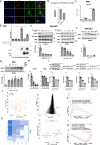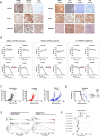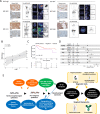Somatostatin receptor 2 expression in nasopharyngeal cancer is induced by Epstein Barr virus infection: impact on prognosis, imaging and therapy
- PMID: 33402692
- PMCID: PMC7785735
- DOI: 10.1038/s41467-020-20308-8
Somatostatin receptor 2 expression in nasopharyngeal cancer is induced by Epstein Barr virus infection: impact on prognosis, imaging and therapy
Abstract
Nasopharyngeal cancer (NPC), endemic in Southeast Asia, lacks effective diagnostic and therapeutic strategies. Even in high-income countries the 5-year survival rate for stage IV NPC is less than 40%. Here we report high somatostatin receptor 2 (SSTR2) expression in multiple clinical cohorts comprising 402 primary, locally recurrent and metastatic NPCs. We show that SSTR2 expression is induced by the Epstein-Barr virus (EBV) latent membrane protein 1 (LMP1) via the NF-κB pathway. Using cell-based and preclinical rodent models, we demonstrate the therapeutic potential of SSTR2 targeting using a cytotoxic drug conjugate, PEN-221, which is found to be superior to FDA-approved SSTR2-binding cytostatic agents. Furthermore, we reveal significant correlation of SSTR expression with increased rates of survival and report in vivo uptake of the SSTR2-binding 68Ga-DOTA-peptide radioconjugate in PET-CT scanning in a clinical trial of NPC patients (NCT03670342). These findings reveal a key role in EBV-associated NPC for SSTR2 in infection, imaging, targeted therapy and survival.
Conflict of interest statement
B.V. is a consultant for Venthera (Palo Alto, US), iOnctura (Geneva, Switzerland) and Karus Therapeutics, Oxford, UK and has received speaker’s fees from Gilead (Foster City, US). T.Me. has acted as a consultant for Tarveda Therapeutics (Watertown, MA, US). G.W. serves as a scientific advisor to ViraTherapeutics and Boehringer Ingelheim. S.M. receives research grants from Pfizer, Bayer, MSD, AstraZeneca, Nextcure, Roche, BMS, Amgen and Lily. M.C. reports personal fees from Astellas, personal fees from Janssen, grants and personal fees from Ferring, personal fees from MSD Oncology, personal fees from Illumina, nonfinancial support from AstraZeneca, personal fees and nonfinancial support from Varian, nonfinancial support from GenomeDx Biosciences, nonfinancial support from Medlever, outside the submitted work. All other authors declare no competing interests.
Figures




References
Publication types
MeSH terms
Substances
Associated data
Grants and funding
LinkOut - more resources
Full Text Sources
Other Literature Sources
Medical
Molecular Biology Databases
Research Materials

